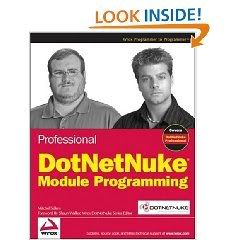
Professional DotNetNuke Module Programming
Product Description
This book was written to provide insight into the development techniques needed (and the options available) to work within the DotNetNuke framework. Emphasis is placed on the available methods to extend the framework, as well as the situations and rules governing when each respective extension model should be used. Along with this emphasis on selecting the right extension method, the book stresses the importance of leveraging the framework in as many areas as possible, and ultimately using the framework to the advantage of the developer, rather than merely working with it.
One current weakness of the DotNetNuke framework is developer documentation. The framework provides developers with numerous amazing methods to extend the framework and build truly robust applications, but as of this writing, minimal API documentation exists, and overall development topics are scattered all over the Internet. Many community members have helped to supplement this lack of developer content by writing blog articles and technical tutorials to help teach the individual concepts, but because there is no central repository, it can be tedious and difficult to find just what you need.
This book helps truly identify and document some excellent new features that are supported starting with DotNetNuke 5.0. The inclusion of jQuery exposes developers to a great JavaScript library that will enable interactive and animated interfaces to be created easily. The new Module Packaging system (discussed in detail in Appendix D) provides module developers and skin designers with many much-needed options when it comes to deploying applications. This book was written to expose this information, and to function as a key resource for the development community.
This book assumes that the reader has a working knowledge of standard ASP.NET development techniques and terminologies. Samples in the book are provided in both C# and Visual Basic (VB) to enable readers with diverse backgrounds to fully understand the concepts presented. Users do not need to have a comprehensive understanding of DotNetNuke prior to using this book because the early chapters discuss the configuration of both DotNetNuke and the development environment, and careful consideration has been taken to ensure that DotNetNuke-specific terminology is explained as the book progresses.
Readers already familiar with DotNetNuke 4.x development will find this book valuable because it introduces many of the new features of the latest software version, although some of the beginning chapters for these readers will be redundant because the overall concepts of environment configuration and basic interface elements have not changed from 4.x to 5.x. Differences between versions 4.x and 5.x are pointed out as appropriate.
As the title implies, this book primarily covers development techniques within the DotNetNuke 5.x platform. The chapters point out similarities and differences between the 4.x and 5.x platforms, enabling readers to apply some newer concepts to the older technology. Although this book primarily focuses on the concept of module development, it discusses other extension models as well, such as skin objects and authentication providers. Also covered in this book are recommended practices for successful integration with the framework.
This book begins with an introduction to development within DotNetNuke. The discussions walk you through DotNetNuke setup, terminology, development environment setup, and options for .NET project setup.
The book then presents a scenario-based model to introduce basic concepts of module development. This is accomplished by building a simple guestbook module that demonstrates how individual portions interact with one another. The discussion lays the foundation for the most basic elements of development within DotNetNuke. Later in the book, you learn about the more advanced module programming concepts, such as optional interfaces and DotNetNuke user controls. This discussion additionally introduces other extension methods, such as authentication providers and skin objects, as well as best practices.
In short, the main content of the book creates a working model that guides you through the most common development scenarios; at the same time, it provides the detail needed to tightly integrate custom code with the framework.
The appendixes provide supplemental information to what is contained in the chapters. This is material that, while not critical to an understanding of the individual chapters, is nonetheless important. The appendixes include items such as community resources and general DotNetNuke configuration items, as well as a detailed look at the new module manifest and a few key integration API points that are not well documented overall.
Downloadhttp://www.uploading.com/files/6O1XPAN7/booktraining_ProfesDotnetnuke.rar.html
http://hotfile.com/dl/3784844/9eed40e/booktraining_ProfesDotnetnuke.rar.html
http://rapidshare.com/files/237211394/booktraining_ProfesDotnetnuke.rar
http://www.enterupload.com/wf1cq2jx9o41/booktraining_ProfesDotnetnuke.rar.html
http://www.easy-share.com/1905364724/booktraining_ProfesDotnetnuke.rar
Readme
Password default : booktraining.net

No comments:
Post a Comment